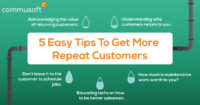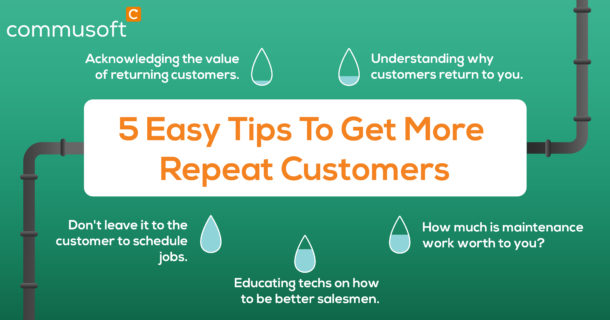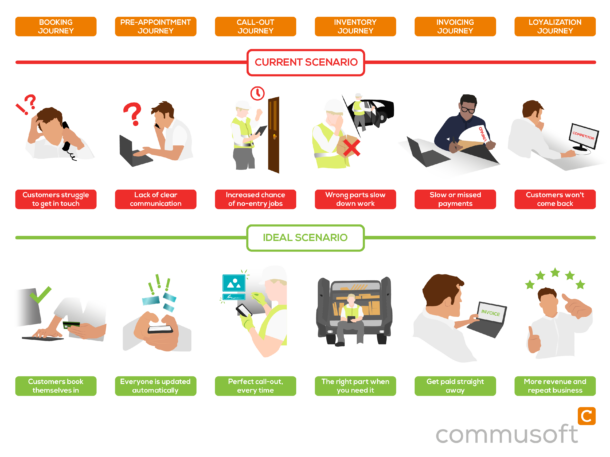It’s every business’ dream to have as many streams of incoming revenue as possible. New customers generally make the bulk of a plumbing business’ revenue but with diversification on many people’s minds nowadays, perhaps it’s time to take a look at some alternatives. What’s one that immediately comes to mind? Repeat customers, of course! Acknowledging Read more
Commusoft

It’s every business’ dream to have as many streams of incoming revenue as possible. New customers generally make the bulk of a plumbing business’ revenue but with diversification on many people’s minds nowadays, perhaps it’s time to take a look at some alternatives. What’s one that immediately comes to mind? Repeat customers, of course!
Acknowledging the value of returning customers
The first step is acknowledging the actual value of customer loyalty. I’m positive you’ve never thought to yourself “I hate loyal customers”; after all, it’s no doubt a good thing to have people choosing to hire you again and again: wear it like a badge of honor! But just because you’re happy about that, it doesn’t necessarily mean you’re properly appreciating the value that these repeat customers provide your business with.
From a statistical point of view, retaining customers is up to 5 times cheaper than acquiring new ones. Returning customers also spend more: up to 300%! That’s a whole lot of value to be taking more seriously, which means strategizing how you can retain even more customers is important, too.
Equally, it helps to keep things in perspective; your plumbing business might be different, so it’s important to sit down with your own numbers and see if they do, in fact, match up to this potential.
Regardless, thinking up strategies to boost your returning customer rate is never going to hurt: even a little can go a long way. If there’s one thing we’ve learned from 2020 it’s that keeping your eggs in the same basket is not ideal, so having diverse streams of income is always a good idea.

Understanding why customers return to you
“Because I did a great job!” is the most natural answer to this question and oftentimes it’s also the right one. But, with competition in the plumbing industry being what it is nowadays, it’s hubris to say that you’re the only plumber in town who can do a good job.
If we’re going to be honest about it, most customers have a hard time telling an average job from a great one. As long as nothing breaks down for a reasonable number of days and there isn’t a massive mess, they won’t think twice about it.
To push the example, check out your own reviews and those of a competitor, then count how many times “great customer service”, “convenient”, “easy to communicate with” and other such phrases are mentioned. Then compare the number against how often “my hot water booster installation was a work of art” shows up.
It’s not the big things you do, but more often the run-of-the-mill details – like sending email confirmations and having techs wear polo shirts – that often make the biggest impact. Some other tips to get more repeat customers (and positive reviews) would be:
- 24/7 availability with the help of an online booking portal
- Keeping customers in the loop with automatic email/text notifications
- Sharing technician arrival times & tracking info so they’re not taken by surprise
- Training your techs & admin to always be presentable and make a good impression
- Sending feedback requests after the work is done
How much is maintenance work worth to you
Servicing appliances isn’t high up on anyone’s list of favorite jobs. It’s mundane, presents little to no challenge, and doesn’t seem to bring in much profit. The latter isn’t difficult to fix – if you use your net profit per hour to set prices instead of gross margins, every job will be a (highly) profitable job.
Regularly servicing appliances helps ensure that they work properly, don’t use up more electricity than they should, and that they last longer. Not to mention it helps avoid dangerous malfunctions that people might not even be aware of. These are all reasons to inform your customers and sell them on a service deal.
This can even work as a sales strategy, where you offer a “subscription plan”. Instead of charging them, say, $164.99 next year, when you come for the maintenance check, they can pay $13.75/month and have a technician available to them at all times for free check-ups and advice. $13.75/month might sound like change, but rack up 50 of these 30-minute jobs, and you’ve got almost $700/month guaranteed for only 25h of work!
Educating techs on how to be better salesperson
A technician’s priority is to do a great job – that’s always going to be true. But they’re also oftentimes the only face-to-face interaction customers have with your plumbing business. The level of trust they’re afforded shouldn’t be taken for granted, which means that pushy sales techniques and tactics don’t have a place in this situation. This being said, a technician can always learn to judge a situation on their own and make recommendations accordingly.
Whether it’s by presenting an additional product (where you can earn a mark-up if you have a good vendor relationship that affords you reduced rates) or a subscription like the one above, they’re in an unique position to make a great impression and help customers decide on hiring you again in the future.
Another way they can help the business is by using a quoting tool to show multiple options for a future project the customer might be interested in. This is the good, better, best approach also known as bronze/silver/gold service. Studies show that people rarely go for the cheapest option when they’re presented with 3 prices; you’re almost guaranteed that they pick the middle, or even the premium one.
Don’t leave it to the customer to schedule your jobs
And speaking of that future project (or maintenance work for that matter): you can’t rely on the customer to call you again. Sure, it’s great that some do, but for the most part and especially for that lucrative service work, people follow a “if it ain’t broke, why fix it” mentality. Chances are they won’t book a job until something breaks down.
This is why sending regular service reminders is essential. Not only does it give them a little nudge, but if you time them right (or better yet, schedule them in advance), they can also help the customer feel like they’re getting a more personalized treatment, seeing how you “remembered” when their appliance was due a check-up.
If you need a few more ideas, this is a complete guide to service reminders.
Simply keeping in touch with customers is essential and I don’t just mean sending them discounts or brochures. If you do decide to commit to a newsletter or regular emails, it’s best to try and keep it engaging. It does take more effort, but don’t overthink it; high production values are overrated. Relatability and being down-to-earth is a lot more valuable so the odd DIY tutorial on how to do an easy fix or some insight from the business (a “Get to know your plumber!” sort of thing) will go a lot further in establishing a long-lasting relationship.
The takeaway
All in all, earning customer loyalty means being great at what you do and having an eye for the kind of details that make a difference. As you grow your plumbing business, it can get more difficult to keep track of everything, from scheduling to payments to customer service.
Digital tools are already a mainstay of our everyday lives and Commusoft is one that strives to make remarkable customer journeys a breeze for any contracting business. If you’re looking to learn more, check out our Customer Journeys page.
 Guest Blogger: Cristina Maria is a Marketing Executive at Commusoft, a job management software company, where she helps educate and empower field service businesses to deliver a remarkable customer experience.
Guest Blogger: Cristina Maria is a Marketing Executive at Commusoft, a job management software company, where she helps educate and empower field service businesses to deliver a remarkable customer experience.

Throughout the years, the forces that have driven the plumbing industry to change and improve have been diverse. From competitors trying new things, to technological advances pushing boundaries, contractors have had to adapt, or get left behind. One driving force that hasn’t always been recognized, however, is the customer. Sure, good contractors and managers have Read more
Throughout the years, the forces that have driven the plumbing industry to change and improve have been diverse. From competitors trying new things, to technological advances pushing boundaries, contractors have had to adapt, or get left behind. One driving force that hasn’t always been recognized, however, is the customer.
Sure, good contractors and managers have always taken into account that customer satisfaction is what keeps a business running, from invaluable word of mouth recommendations to the ever-profitable returning customer strategies, but the fact of the matter is that customers themselves have changed. Tech giants like Amazon and Facebook permeate every aspect of our culture and they’ve reshaped expectations so much that simply doing a good job just isn’t enough anymore.
The fact that customers expect so much from every company they interact with (even if they’re not a tech giant) has already been discussed and dissected. After all, 2020 was the year customer experience became more important than price. Now, the pressure is on plumbing and contracting companies to make sense of these expectations and find a way to implement changes. That, however, is easier said than done. How do you turn a plumbing company into Amazon?
This is where customer journeys come in. And no, that’s not a typo. We do mean customer journeys, as a plural. That’s because the complete sum of interactions between a customer and a field service business is not singular; their experience is made up of many interactions that require individual attention, but ignoring this fact is an error that many managers make.

1. The customer isn’t the most important one, they’re the only one!
For example, what’s the first thing a customer has to do in order to hire you? Book an appointment, right? Well, that’s the booking journey. How many steps are there to go from needing a plumber to having an appointment scheduled? Where do you lose customers along the way? How can you remove friction so that the process is so smooth, the customer never gets a chance to change their mind?
Basically, if you can turn your booking journey into something resembling Amazon’s “1-Click Buy” button, you’ll have significantly improved your lead conversion rate. You’ll earn more money for each dollar spent on getting leads to your website, increase your chances that the customer will continue through to the next journey, and encourage re-bookings in the future.
The same applies throughout each additional journey, as highlighted in the image above. The more points of friction you have, the more negative the overall experience and that’s even if the customer’s problem was fixed! It can be overwhelming (especially to smaller businesses) to take into account every single interaction, but by mapping the customer journey, it becomes far more manageable.
For example, in the booking journey we mentioned above, most people expect to book an appointment the same way they book a dinner reservation. Therefore, an automatic booking portal is the tool you need to offer that experience. A quote? Why would they wait days for the office staff to send one, or even weeks, when they’re so used to seeing prices online?
Providing instant digital quotes will impress the customer, help upsell them on premium plans (because they can clearly see their options and the benefits shown on multiple quotes), and save your admin time.
Learn more about online portals and customer experience here!
2. How do plumbing technicians benefit from great customer journeys?
The reason customer journeys will define 2021 as well as the coming years (a bold claim, we know!) is because despite the name, rather than targeting a single shareholder, it stands as a holistic strategy for a business.
From a technician’s point of view, an easy job is one they can do as efficiently as possible. That means taking as few trips back and forth to the office between jobs (ideally none), for the customer to be aware of the visit & available when they do arrive, and finally: to be able to support any query the customer may have, all whilst in the field.
When you’re aiming to offer a smooth pre-appointment, call-out, and inventory journey to your customers, all these imply having the right tool to make your technician’s day fly by. The customer is kept up-to-date via notifications so they know to be are available, and technicians can expect to know whether the parts the installation needs are available; these are just a few of the benefits that work to make everyone’s lives easier.
3. How does your office staff benefit from great customer journeys?
Frictionless customer journeys are tightly linked to the concept of customer self-service and business automation. Much like booking a stay on Booking.com, the customer does part of the work, whilst software takes care of reminders, invoicing, and even feedback requests.
On the customer side, they’re happy because they feel in control of their experience and can get results quickly with near instantaneous confirmations every step of the way, establishing peace of mind.
The admin side is where the greatest benefits truly lie.
Software automation can’t replace office staff when it comes to complex tasks and building relationships, but it can support them to deliver their best work by removing repetitive and time-consuming parts of their day, like emailing confirmations and double-data entry. More efficient admins means you can hire more technicians, and get more work done with the same amount of resources.
4. The Takeaway
All in all, customer journeys are a complex concept and no one expects a business owner to get it perfect from the beginning. However, as we move into 2021 and learn to live with the challenges we’ve faced in 2020, it’s true that customer expectations will continue to rise, but quality customer journeys can help you face them.
Digital tools are already a mainstay of our everyday lives and Commusoft is one that strives to make remarkable customer journeys a breeze for any contracting business. If you’re looking to learn more, check out our Customer Journeys page.
 Cristina Maria is a Marketing Executive at Commusoft, a job management software company, where she helps educate and empower field service businesses to deliver a remarkable customer experience.
Cristina Maria is a Marketing Executive at Commusoft, a job management software company, where she helps educate and empower field service businesses to deliver a remarkable customer experience.
